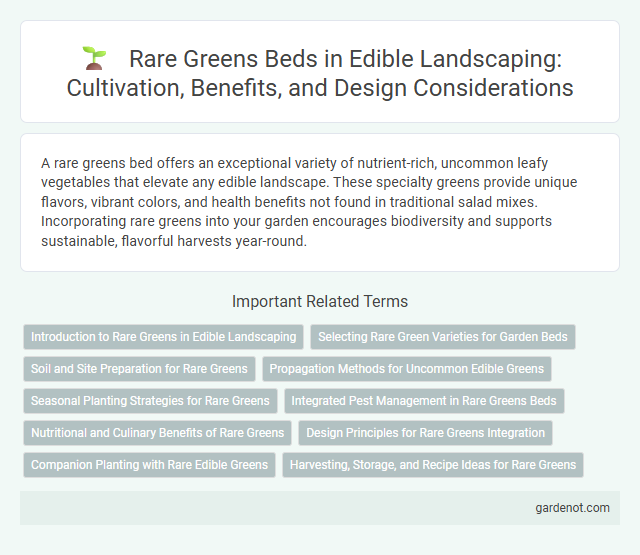A rare greens bed offers an exceptional variety of nutrient-rich, uncommon leafy vegetables that elevate any edible landscape. These specialty greens provide unique flavors, vibrant colors, and health benefits not found in traditional salad mixes. Incorporating rare greens into your garden encourages biodiversity and supports sustainable, flavorful harvests year-round.
Introduction to Rare Greens in Edible Landscaping
Rare greens in edible landscaping introduce unique, nutrient-rich varieties that enhance garden biodiversity and culinary diversity. These uncommon leafy vegetables, such as mizuna, sorrel, and claytonia, offer distinct flavors and vibrant colors, making them a functional and aesthetic addition to edible gardens. Incorporating rare greens supports sustainable gardening by promoting resilience and reducing reliance on common crops.
Selecting Rare Green Varieties for Garden Beds
Selecting rare green varieties for garden beds enhances biodiversity and introduces unique flavors and textures to edible landscapes. Varieties such as Watercress, Malabar Spinach, and Red Orach thrive in well-prepared soil beds, offering nutrient-rich, visually appealing foliage. Incorporating these uncommon greens supports sustainable gardening practices by diversifying plant genetics and extending harvest periods.
Soil and Site Preparation for Rare Greens
Soil and site preparation for a rare greens bed requires well-draining, nutrient-rich soil with a slightly acidic to neutral pH between 6.0 and 7.0, ensuring optimal nutrient availability. Incorporating organic matter such as compost or aged manure enhances soil structure, moisture retention, and microbial activity essential for rare greens' delicate root systems. Selecting a site with partial shade and protection from strong winds supports tender foliage growth while preventing stress and bolting in rare green varieties.
Propagation Methods for Uncommon Edible Greens
Propagation methods for uncommon edible greens in a rare greens bed emphasize seed saving and cuttings to maintain genetic diversity and adapt to local growing conditions. Utilizing techniques such as tissue culture and layering enhances the success rate of cultivating fragile or slow-growing varieties. Careful management of propagation environments ensures healthier seedlings and stronger plant development for sustainable edible landscapes.
Seasonal Planting Strategies for Rare Greens
Seasonal planting strategies for rare greens involve selecting varieties suited to specific climate zones and timing sowing to maximize yield during cooler months. Utilizing succession planting and intercropping techniques enhances continuous harvests and optimizes space in an edible landscape. Incorporating cold frames or row covers extends the growing season, providing protection from frost and promoting healthy growth of rare greens.
Integrated Pest Management in Rare Greens Beds
Integrated Pest Management (IPM) in rare greens beds emphasizes using natural predators, crop rotation, and biological controls to minimize pesticide reliance while protecting delicate species like tatsoi and mizuna. Regular monitoring and soil health management reduce pest outbreaks and promote resilient plant growth. This approach ensures sustainable cultivation, maintaining both biodiversity and optimal yield in edible landscapes.
Nutritional and Culinary Benefits of Rare Greens
Rare greens, such as sorrel, dandelion, and mustard greens, are rich sources of vitamins A, C, and K, as well as essential minerals like iron and calcium. Their unique flavors, ranging from tangy to peppery, enhance a variety of culinary dishes, adding depth and complexity to salads, soups, and sautes. Incorporating rare greens into the edible landscape promotes biodiversity and offers nutrient-dense options for health-conscious cooking.
Design Principles for Rare Greens Integration
Design principles for integrating rare greens into edible landscapes emphasize biodiversity, spatial harmony, and sustainability. Selecting rare greens with varying textures, colors, and growth habits enhances visual interest and supports ecosystem health. Proper bed arrangement maximizes sunlight exposure and soil nutrients, ensuring optimal growth and long-term garden resilience.
Companion Planting with Rare Edible Greens
Companion planting with rare edible greens enhances biodiversity and natural pest control in edible landscapes, promoting healthier growth without synthetic chemicals. Strategic pairings, such as arugula with chives or sorrel with borage, improve soil nutrients and attract beneficial insects. Cultivating rare greens like shiso, mizuna, and celtuce together maximizes space and yields while preserving unique flavors and nutritional profiles.
Harvesting, Storage, and Recipe Ideas for Rare Greens
Harvest rare greens such as sorrel, mizuna, and red veined sorrel early in the morning to preserve their vibrant flavors and nutritional value. Store these greens in a breathable container or paper towel-lined bag inside the refrigerator to maintain crispness for up to a week. Incorporate rare greens into recipes like tangy sorrel pesto, spicy mizuna salad with sesame dressing, or sauteed red veined sorrel paired with garlic for a unique gourmet twist.
Rare greens bed Infographic

 gardenot.com
gardenot.com